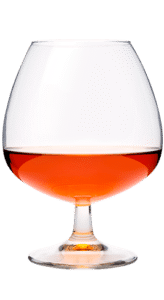

Brandy is a class of spirits that is distilled from grape wine, the pomace left over from winemaking, or the fermented juice from other fruits. Most grape brandies are aged in oak, while the fruit and pomace brandies are unaged and clear. Origin: In the 16th century, brandy was believed to be created as a more cost-effective way to ship wine. By distilling the wine and removing the water content, ships were able to send more alcohol by volume overseas and sell it as wine again after adding the water back to the liquid. The Dutch liked the concentrated wine as it was, calling the new product brandewijn, or “burnt wine,” which then became anglicized to brandy.
SPIRIT STYLES

COGNAC
Cognac is a region in France, producing some of the finest brandies in the world. Cognac is both a type of brandy and the region in France that produces it. It’s an aged, grape-based brandy that usually comes with a tremendous depth of flavor. Younger cognacs often present light fruit and oak notes, with older ones blooming into lots of dried fruit and spice. Cognac is usually bottled at 80 proof (40% ABV).
By law, you can’t make cognac outside of Cognac, and even inside Cognac you must use specific grapes, and follow specific aging restrictions. Most cognac contains a blend of brandies and is labeled according to the period of time the youngest brandy of the bunch has spent aging in oak casks. In general, the average age of the blend is much older than that of the youngest brandy, with many XOs easily reaching an average age of twenty years.

ARMAGNAC
A little harder to find than cognac, Armagnac is nonetheless available at most quality liquor stores. Like Cognac, it’s named after the region of France which produces it, and only brandies made there can legally be called Armagnacs. Fruitier than its cousin early on due to a different distilling process, Armagnac transitions into caramel and toffee notes as its ages and takes on more character from the wood. Armagnac is usually bottled at 92-96 proof (46-48% ABV).
Also, Like cognac, Armagnac must adhere to certain labeling requirements, with the classification built on the age of the youngest brandy in the blend. Armagnacs designated by the year of their bottling are common, and you can find many a liquor store in France with a wide selection reaching back fifty years or more.

AMERICAN
American brandy, like American wine, suffered from a bad rap for a long time. Well past the time, in fact, when it had actually changed for the better. No more: people know now that you can get some amazing wines from California, Oregon, and other parts of the US … and some of those wines are being distilled and aged in oak, just like their French cousins. The flavor profile of American brandy is usually like that of cognac, though because the Americans are free to use a wider variety of grapes, there is a broad range of possibilities.
Like Cognac, American brandies often use the VS, VSOP, and XO classifications to denote the age and quality of the liquor within, although unlike Cognac and Armagnac, those designations are not legally enforced. Because American brandies are, shall we say, not always quite so refined as their French cousins, I recommend VSOP or better. The good news: American brandy is often a fraction of the price of Cognac or Armagnac. In fact, finding any other oak-aged liquor at these prices, whiskey or brandy or otherwise, is almost impossible. E&J XO, for example, is a terrific brandy that’s on par with many VSOP Cognacs, can be had for about $15 at many liquor stores.

APPLE BRANDY/ APPLEJACK
This is Calvados’s wild, unrefined, American cousin. Originally made by repeatedly freezing hard apple cider and skimming the ice from the top, thus slowly increasing the alcohol content, it’s now most typically distilled and stored in the same manner as Calvados. Generally speaking, apple brandies (and applejack in particular) have a heartier apple flavor than French entries, and are a little rougher around the edges, owing in part to the fact that there’s no clear-cut grading system established. Don’t let that frighten you, though. Applejack is inexpensive and delicious, and many American apple brandies are just as fine as Calvados.
